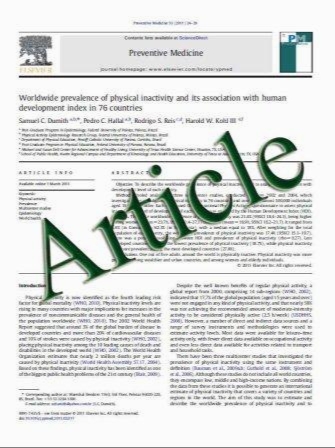Relationships of muscle strength and bone mineral density in ambulatory children with cerebral palsy
- نوع فایل : کتاب
- زبان : انگلیسی
- مؤلف : C.-L. Chen & K.-C. Lin & C.-Y. Wu & J.-Y. Ke & C.-J. Wang & C.-Y. Chen
- چاپ و سال / کشور: 2011
Description
Summary This work explores the relationships of muscle strength and areal bone mineral density (aBMD) in ambulatory children with cerebral palsy (CP). The knee extensor strength, but not motor function, was related to aBMD. Thus, muscle strength, especially antigravity muscle strength, was more associated with aBMD in these children than motor function. Introduction Muscle strength is related to bone density in normal children. However, no studies have examined these relationships in ambulatory children with CP. This work explores the relationships of muscle strength and aBMD in ambulatory children with CP. Methods Forty-eight ambulatory children with spastic CP, aged 5–15 years, were classified into two groups based on Gross Motor Function Classification System levels: I (n=28) and II (n=20). Another 31 normal development (ND) children were recruited as the comparison group for the aBMD. Children with CP underwent assessments of growth, lumbar and distal femur aBMD, Gross Motor Function Measure-66 (GMFM-66), and muscle strength of knee extensor and flexor by isokinetic dynamometer. Results The distal femur aBMD, but not lumbar aBMD, was lower in children with CP than in ND children (p< 0.05). Children with level I had greater knee flexor strength and GMFM-66 scores than those with level II (p<0.001). However, the knee extensor strength and distal femur and lumbar aBMD did not differ between two groups. Regression analysis revealed the weight and knee extensor strength, but not GMFM-66 scores, were related positively to the distal femur and lumbar aBMD (adjusted r2=0.56–0.65, p<0.001). Conclusions These results suggest the muscle strength, especially antigravity muscle strength, were more associated with the bone density of ambulatory children with CP than motor function. The datamay allow clinicians for early identifying the ambulatory CP children of potential low bone density.
Osteoporos Int DOI 10.1007/s00198-011-1581-6 Received: 22 October 2010 / Accepted: 31 January 2011


